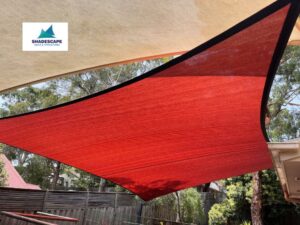Want to turn that sun-baked patch in your backyard into a cool, shady hangout? Shade sails are the secret weapon you’ve been looking for. They’re more than a stylish feature—they shield you from harsh sun and instantly give your patio, garden, or pool area a relaxed, resort-like vibe. If you’ve ever admired one but thought installation looked too tricky, you’re about to see just how doable it is.
In this guide, I’ll walk you through the whole process in plain English. We’ll plan things out, pick the best bits and pieces, get your sail up the right way, and look at how to keep it looking sharp. Whether you’re a first-timer or have a couple of DIY projects under your belt, by the end you’ll be ready to create your own shaded oasis.
Planning for Success in Shade Sail Installation
Don’t rush—good planning makes everything easier and saves headaches down the track.
Choosing the Right Location
Take a wander outside. Where does the sun hit hardest during the day? Where do you wish you had a bit more shade? Check for strong existing anchors like a brick wall, a big tree, or sturdy posts. If you don’t see any, don’t worry—you can always put new posts in.
Think about how you’d use the shaded spot:
- Poolside shade? You’ll want to block out the fiercest afternoon rays so nobody’s frying on the deck.
- Entertaining area or outdoor dining? Shift your shade to cover where you’ll be sitting at breakfast or dinner time.
Don’t forget to look up your local council rules; some areas need permits, especially if you’re adding posts or mounting onto your house or a building.
Designing Your Shade Sail
There’s more to this than picking a colour! Triangular sails—like those you’ll find in our residential shade sails range—look sleek and work great in tight spots or tucked into corners. Rectangular sails are your go-to for covering bigger areas like patios or play zones.
For the best look (and to help with rain running off), use different heights for your mounting points. That creates that cool twist you see in shade sails, plus it keeps water from pooling.
Measuring and Sizing
Grab some rope or string and map out where your sail will go. Take measurements from each anchor point, and remember: your sail needs to be a bit smaller than the gap to give the hardware some space. Leaving about 6–12 inches on every side keeps things neat and tensioned.
Plan things out now, and putting up your sail will be a breeze later!
Strategy for Materials and Tools
Get your kit sorted before you start—it’ll save you multiple trips to the hardware store.
Essential Materials for Installation
Here’s what you’ll need:
- Shade sail fabric: Go for tough, breathable material that’ll shrug off the sun and weather—HDPE (High-Density Polyethylene), often chosen for commercial shade sails, or marine-grade is best. Those reinforced edges and strong D-rings aren’t just for show; they make a huge difference.
- Mounting hardware: Grab quality stainless steel D-rings for the corners, heavy-duty eye bolts for walls, adjustable turnbuckles for tightening, and some snap shackles if you want to take the sail down easily.
If you’re adding posts, use pressure-treated timber or galvanised steel—and make sure they’re set firm in concrete. For long-term performance, check out our maintenance and repair tips.
Selecting the Right Tools
Have these to hand:
- Drill (with bits for both wood and brick/concrete)
- Tape measure and a level (you’ll thank yourself later)
- Socket set or good spanner
- Gloves and safety glasses (no scraped knuckles or flying bits, please)
- Post-hole digger, concrete mix, and a wheelbarrow if you’re setting posts
Get everything together first. There’s nothing worse than realising midway that you’re missing a vital piece.
Step-by-Step Guide for How to Shade Sail Installation
Let’s get into it—step by step, so you’re not left scratching your head.
How to Attach Sail Shades
- Anchors first: Whether you’re screwing into a wall, setting into a fence, or installing posts, make sure those anchors are absolutely solid. Mount into brick, concrete, or solid timber. For fences, double-check for any wobbles.
- Posts: If you’re adding your own, make the hole at least a third the height of the post deep—so if your post is 9 feet, dig 3 feet down. Set it in concrete, make sure it’s upright, and leave it to set properly (a day or two is best before you hang your sail).
How to Install Shade Fabric
- Lay the sail on the ground and double-check which edge goes where.
- Attach your highest corner first, but don’t pull it tight just yet.
- Move around the sail, clipping each corner on. Keep things a little loose for now.
- Start tensioning—use your turnbuckles or ratchet, tightening each corner a bit at a time and working your way around. Keep going until the whole sail is tight and smooth, not saggy or wrinkled.
- Don’t forget to keep at least a foot of height difference between the highest and lowest points for every 10 feet across—this makes sure rain won’t pool and wind whips past without causing trouble.
How to Hang a Triangular Shade Sail
These ones are easy once you know how:
- Give each corner some breathing room—keep them away from sharp edges, fences, or furniture.
- Put the shortest edge facing the direction where strong winds usually come from for the best stability (and fewer flap attacks).
How to Install a Sail Over a Patio
Some setups need a mix of posts and wall anchors. For extra coverage and flexibility in your outdoor space, consider exploring outdoor umbrellas as a complementary shade solution.
- Put posts where people aren’t likely to trip over or bump into them.
- Use solid spots on your home’s wall, making sure water flows away from the base (nobody wants soggy footings!).
Troubleshooting Common Challenges
- Wrinkles in the sail? Loosen all tension points, straighten things up, and re-tighten a little at a time.
- Sail’s flapping wildly in the wind? You’re probably not tight enough, or your anchor heights are too similar—try increasing the tilt.
- Still stuck? It’s totally fine to call in the pros—it’s better than struggling for hours or making the problem worse!
Caring for Your Shade Sail Post-Installation
If you want your sail to last, a little love goes a long way.
How to Maintain the Integrity of Sail Shades
Check the hardware—especially after wind or storms. For a full guide on keeping everything secure, check out our maintenance and repairs tips. Look for loose eye bolts, rust, or any bit of the sail that’s starting to fray. A quick tighten here and there can save you bigger repairs later.
Cleaning Shade Sail Fabrics
- Twice a year, mix a squirt of gentle detergent into water, use a soft broom or sponge, and give your sail a gentle scrub.
- Skip the pressure washer—those can wreck the fabric in no time.
- Rinse well, then let the sail dry properly before putting it back up.
Seasonal Storage Tips
When wild weather’s coming—a big storm, snow, or days of strong wind—take your sail down. Let it dry if it’s damp, then roll it up and tuck it away somewhere clean until the skies clear. When you pull it back out, check all the parts before reinstalling.
FAQs
How big should my shade sail be?
Measure your total area, then subtract about a foot on each edge to make room for the fixtures and stretching. Too big and you’ll never get it tight!
How do I stop wind damage?
Give your sail a proper slope and tension it nice and firm. If the weather gets wild, take it down—you’ll save yourself a lot of hassle.
Can I attach a shade sail to my old timber fence or house?
If the timber is solid and not rotting or loose, you should be okay. But if you’re at all unsure, check with a tradie or builder first.
Are these things high-maintenance?
Nope! Just give it a quick check whenever the weather turns, clean it every now and then, and keep an eye on any loose bits.
Transform Your Space Today
Putting up a shade sail is one of those projects that feels like magic—you walk outside and your space is totally transformed. With a bit of planning and a handful of tools, you’ll have your spot cool, shaded, and looking sharp in no time. Gather your supplies, rope in a friend if you need to, and enjoy a shady escape where you can relax and unwind. You’ll never look at your backyard the same way again!








